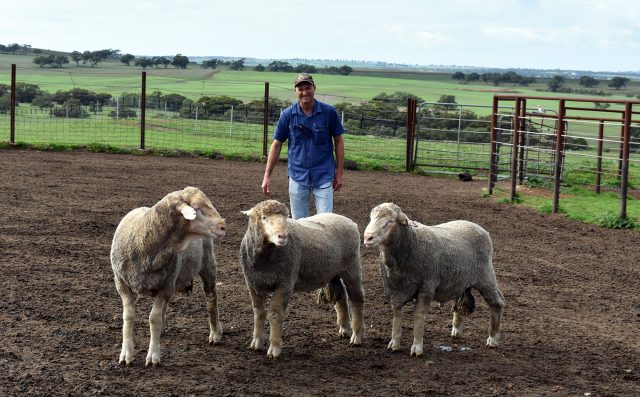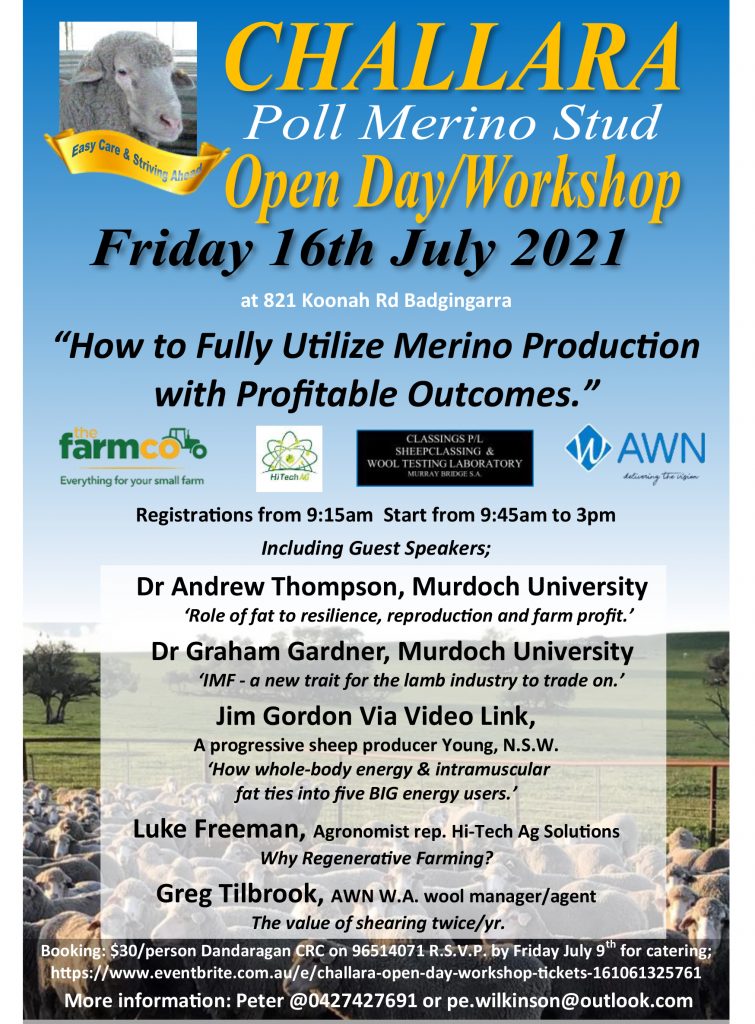In the early nineties, tired of chasing fly blown sheep around their Badgingarra farm, Peter Wilkinson and his father Ron of Challara Poll Merino Stud turned to science for a solution. What they found not only solved their fly strike issues but enabled them – through selective breeding – to produce a plain and productive dual-purpose sheep perfectly suited to the Badgingarra area.
Ron had been successfully farming traditional merino sheep since the 1960’s, but was aware they weren’t ideally suited to the high-rainfall conditions of the area. Challara’s long-term average rainfall is 550 mm annually and greening of the fleece, fleece rot and fly strike were ongoing challenges. Rather than continuing to treat these problems symptomatically, they looked at solutions to minimise or eliminate them at the source.
Peter explains, “The root of the change was when my father read an article from Dr Jim Watts and he was very impressed by it. It was basically saying that by getting the science of the skin right, we can breed a type of sheep that has more fly-resistant wool. It was a light bulb moment for Dad.”
Dr Jim Watts was a research veterinarian specialising in skin and fleece biology. Considered a wool science revolutionary, he developed the Soft Rolling Skin (SRS) breed of merino – a plain-bodied, wrinkle-free sheep with loose, thin skin capable of producing wool of better quality and in greater quantities.
Adopting Dr Watts’ research set Challara on a new path. By visually identifying and selecting sheep used for breeding, they have not only found themselves with a better wool-producing sheep, but one that is also early to mature, worm resistant and more fertile than a traditional-bred merino.
“This isn’t something we were looking for when changing our breeding direction,” said Peter. “Without changing our nutrition much, just through genetic selection, we have lifted our fertility by 15-20%.
“In the 80’s and 90’s we were happy with an 85% lambing rate, now I’m disappointed if we don’t get over 100%!”
While muscle scanning and other technology is used, it is the visual evaluation — applying Dr Watts’ theory — of the family groups by Peter that really lets him know what has worked and what hasn’t.
“Our progeny testing is very important. I like to see what is going on right then and there and record it with a pen and paper – I’m old school like that,” he laughs.
“Merinos have over thirty different traits to look out for, so there’s a huge number of things to consider. We never get it perfect, but we tick as many boxes as we can and try and lift that level every year.”
Wool from a Challara sheep is fast growing, long stapled, deep crimping and soft handling. “We do fetch top prices for the wool quality and when you put your hand on the animal the first thing that you will notice is the softness,” said Peter.
Challara wool shorn in March 2021 from six months growth recently sold for 941c/kilogram greasy; 1535c/kg clean. It had 61.3% yield, 65mm length and 19.2 microns.
“We have been increasing the average length of wool, density is improving and the micron is stable, with a tendency to decrease,” said Peter. “A testament to this progress is the fact that we had to move to shearing twice per year in March 2012.”
Peter’s enthusiasm for his breeding technique and eagerness to embrace emerging research in the field has led to him opening up Challara Farm for an open day. With the theme of How to Fully Utilize Merino Production with Profitable Outcomes, the day will combine a practical workshop, panel discussion and lectures from a range of speakers including Drs Andrew Thompson and Graham Gardner from Murdoch University, Australian Wool Network WA Wool Manager and agent Greg Tilbrook.
“There’s still a fair bit of scepticism in the commercial world regarding us doing things differently with our breeding,” said Peter.
“At larger field days, most people head straight to the stud they have been going to for years and carry on and talk to them,” said Peter. “I’m not pushing any agendas – I’m just a passionate wool producer and I believe in what I’m doing.
“There is a lot of really good sheep research around that producers may not be aware of. If you’re not aware of it you’re not going to apply it.
“As a stud breeder, I want to help more commercial producers to make more money and do better. It’s rewarding for them and rewarding for me.”
With an increasing number of consumers demanding wool from humanely-treated sheep, an SRS merino is a future-proof breed with natural traits that eliminate or minimise the need for controversial practices such as tail docking and mulesing.
“We still do conduct a small mules on the lambs, but we use best practice when we do,” explains Peter. “We use Tri-Solfen pain relief straight on the skin and you absolutely notice the difference, they are up and about quickly and get straight up back to mum.
“Animal welfare is a big issue for the consumer and industry. You certainly don’t want to see the lamb suffer and I want to be on the front foot doing the right thing by animal welfare. I want to lead by example and say, it’s working for us.”
Being a worm-resistant breed means less chemicals are used in their management and the sheep are generally more content when not being plagued by pests.
“The science Dr Watts developed from the correlation between skin and wool has certainly been proven here. It did not happen overnight, it’s been a long journey, but I can say right now if it wasn’t working, we wouldn’t still be doing it.”
Challara’s Open Day/Workshop is being held on Friday 16 July, with registrations from 9.15am. You can RSVP by contacting Peter on 0427 427 691 or via email pe.wilkinson@outlook.com.









